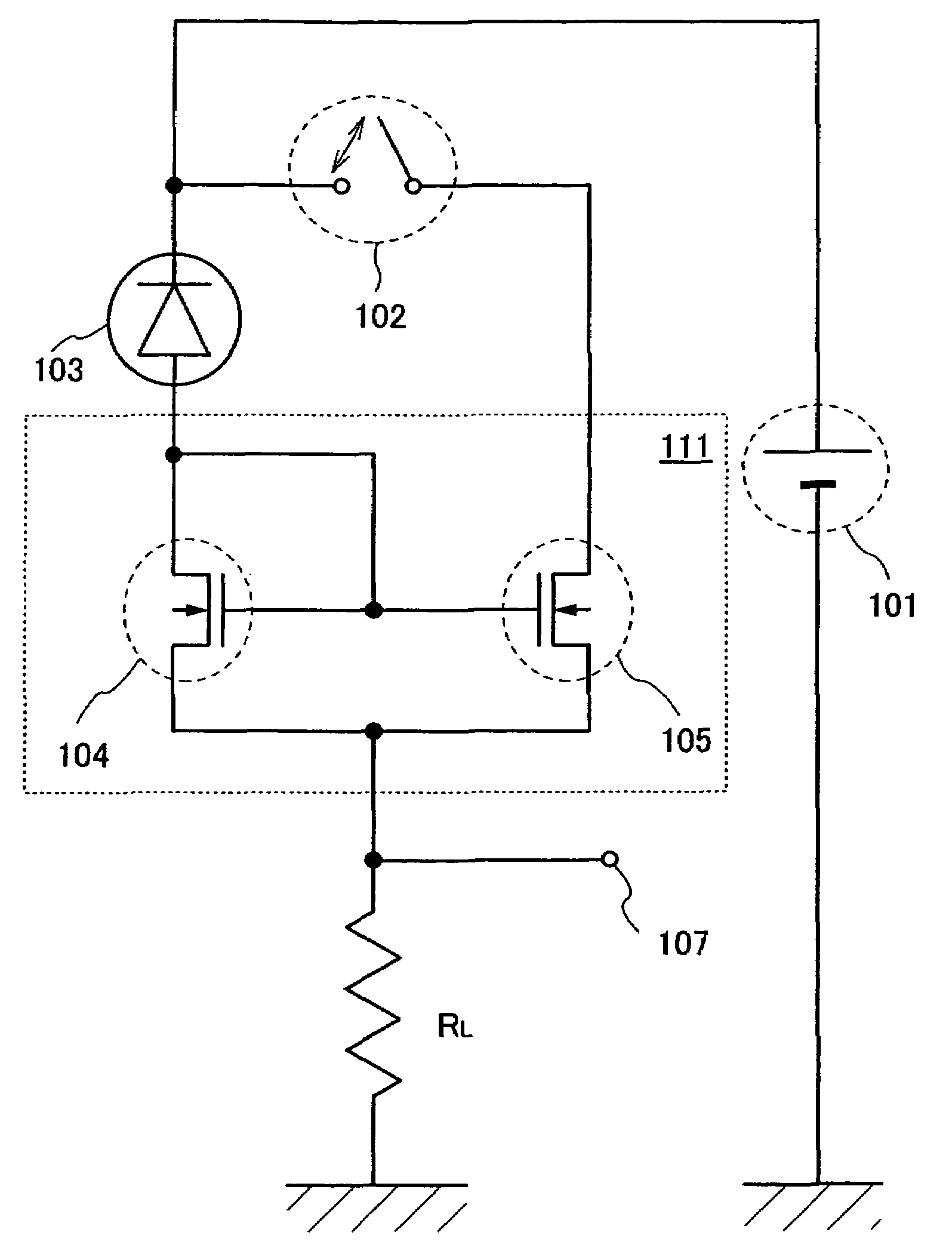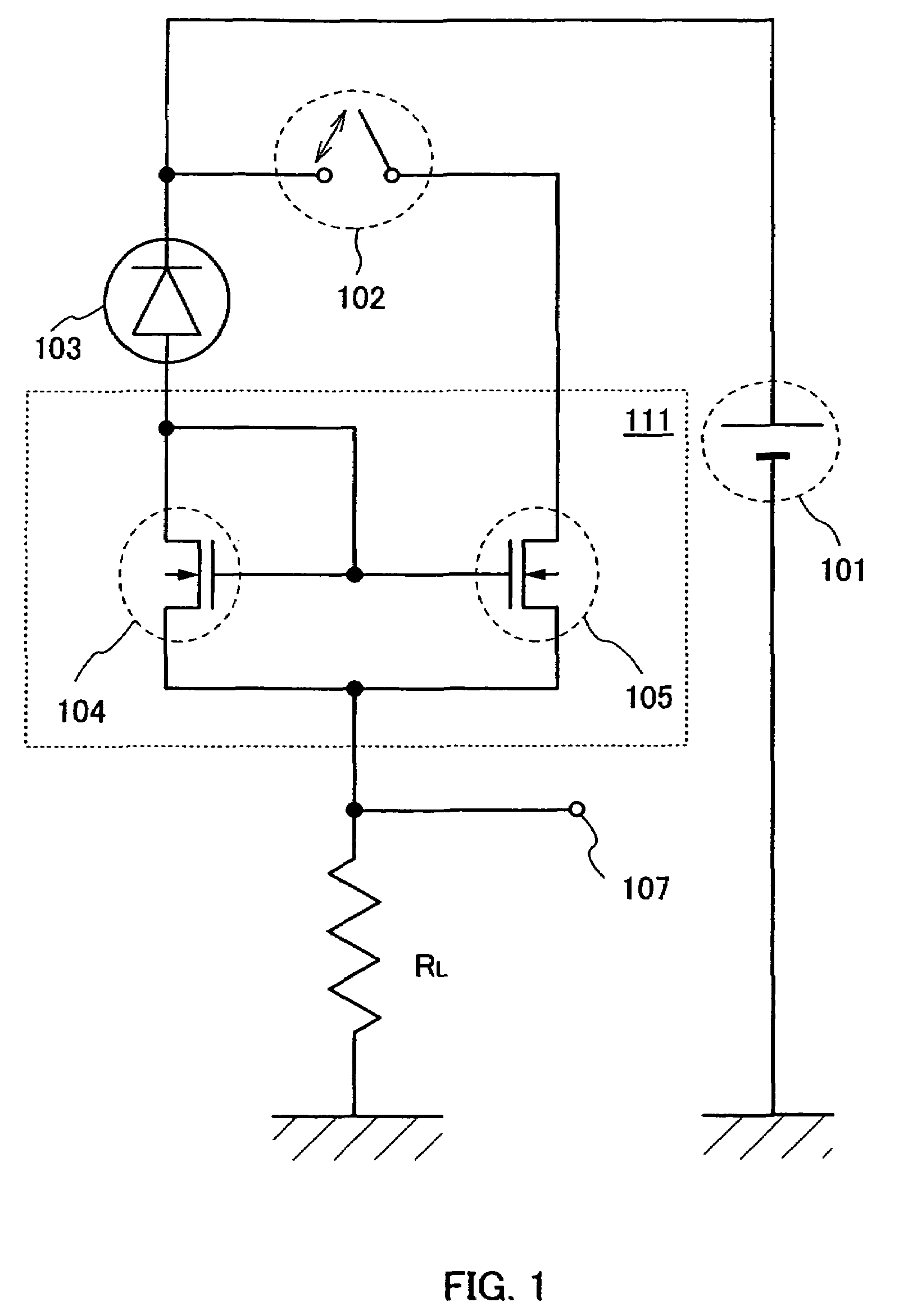Semiconductor device comprising a photoelectric current amplifier
a semiconductor device and amplifier technology, applied in the field of semiconductor devices having photoelectric conversion elements, can solve the problems of reducing the voltage used for one level, reducing the resolving power, and expanding the range of output current, so as to achieve the effect of widening the detectable range of light intensity and narrowing the absolute value of output curren
- Summary
- Abstract
- Description
- Claims
- Application Information
AI Technical Summary
Benefits of technology
Problems solved by technology
Method used
Image
Examples
embodiment 1
[0094]This embodiment will be explained with reference to FIGS. 6A and 6B, FIGS. 7A to 7D, FIGS. 8A to 8D, and FIGS. 9A to 9C. It is to be noted that the same reference numerals as those explained in “BEST MODE FOR CARRYING OUT THE INVENTION” are used.
[0095]First, an element is formed over a substrate (a first substrate 210). Here, AN 100 that is one of glass substrates is used as the substrate 210.
[0096]Subsequently, a silicon oxide film containing nitrogen which serves as a base insulating film 212 (100 nm thick) is formed by a plasma CVD method, and a semiconductor film such as an amorphous silicon film containing hydrogen (54 nm thick) is stacked thereover without being exposed to atmospheric air. In addition, a silicon oxide film, a silicon nitride film, and a silicon oxide film containing nitrogen may be stacked to form the base insulating film 212. For example, a silicon nitride film containing oxygen having a thickness of 50 nm, and further, a silicon oxide film containing n...
embodiment 2
[0146]In this embodiment, an example in which an amplifier circuit is made of a p-channel TFT will be explained with reference to FIG. 5 and FIGS. 10A and 10B. It is to be noted that the same portions as those in Embodiment Mode and Embodiment 1 are denoted by the same reference numerals, and the same portions may be formed on the basis of the manufacturing process described in Embodiment Mode and Embodiment 1.
[0147]In a case where an amplifier circuit, for example, a current mirror circuit 203 is made of p-channel TFTs 201 and 202, a p-type impurity, for example, boron (B) may be substituted for the impurity imparting one conductivity type to the island-like semiconductor region in Embodiment Mode and Embodiment 1.
[0148]An equivalent circuit diagram of a light sensor of this embodiment in which the current mirror circuit 203 is made of the p-channel TFTs 201 and 202 is shown in FIG. 5, and cross-sectional views thereof are shown in FIGS. 10A and 10B.
[0149]In FIG. 5 and FIG. 10A, te...
embodiment 3
[0154]In this embodiment, an example of a light sensor in which an amplifier circuit is formed by using a bottom gate TFT and a manufacturing method thereof will be explained with reference to FIGS. 11A to 11E, FIGS. 12A to 12D, and FIGS. 13A and 13B. It is to be noted that the same portions as those in Embodiment Mode and Embodiments 1 and 2 are denoted by the same reference numerals.
[0155]First, a base insulating film 212 and a metal film 311 are formed over a substrate 210 (refer to FIG. 11A). As the metal film 311, in this embodiment, a film in which tantalum nitride (TaN) having a thickness of 30 nm and tungsten (W) having a thickness of 370 nm are stacked is used, for example.
[0156]In addition, as the metal film 311, as well as the above film, a single-layer film made of an element selected from titanium (Ti), tungsten (W), tantalum (Ta), molybdenum (Mo), neodymium (Nd), cobalt (Co), zirconium (Zr), zinc (Zn), ruthenium (Ru), rhodium (Rh), palladium (Pd), osmium (Os), iridium ...
PUM
 Login to View More
Login to View More Abstract
Description
Claims
Application Information
 Login to View More
Login to View More - R&D
- Intellectual Property
- Life Sciences
- Materials
- Tech Scout
- Unparalleled Data Quality
- Higher Quality Content
- 60% Fewer Hallucinations
Browse by: Latest US Patents, China's latest patents, Technical Efficacy Thesaurus, Application Domain, Technology Topic, Popular Technical Reports.
© 2025 PatSnap. All rights reserved.Legal|Privacy policy|Modern Slavery Act Transparency Statement|Sitemap|About US| Contact US: help@patsnap.com



